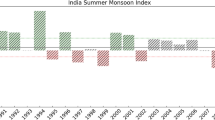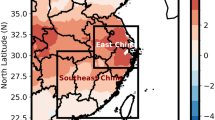Abstract
Based on analysis and simulation, the interaction of thermal forcing between the Tibetan Plateau (TP) and Iranian Plateau (IP) in summer is investigated. Associated influences on water vapor transport in the Asian subtropical monsoon region and the formation of a cold center in the lower stratosphere over Eurasia are also investigated. Results show that surface sensible heating (SH) over the two plateaus not only have mutual influences but also feedback to each other. SH over the IP can reduce the SH and increase the LH over the TP, whereas the SH over the TP can increase surface heating over the IP, thereby reaching quasi-equilibrium among the SH and LH over the TP, IP SH and atmosphere vertical motion. Therefore, the so-called Tibetan-Iranian Plateau coupling system (TIPS) is constructed, which influences atmosphere circulation. In the TIPS system, interaction between surface SH and LH over the TP plays a leading role. SH of the IP and TP influences on other regions not only have superimposed effects but also mutually offset. Accounting for contributions to the convergence of water vapor transport in the Asian subtropical monsoon region, TP SH contributes more than twice that of the IP. The combined influence of SH over TP and IP represents the major contribution to the convergence of water vapor transport in that region. In addition, the heating effect of TIPS increases the upper tropospheric temperature maximum and lifts the tropopause, cooling the lower stratosphere. Combined with large-scale thermal forcing of the Eurasian continent, the TIPS produces a strong anticyclonic circulation and the South Asian High that warms the upper troposphere and cools the lower stratosphere, thereby affecting regional and global weather and climate.
Similar content being viewed by others
References
Bian J C. 2009. Research progress on the vertical structure of the upper troposphere/lower stratosphere (in Chinese). Earth Sci, 24: 262–271
Chen P. 2001. Thermally forced stationary waves in a quasigeostrophic system. J Atmos Sci, 58: 1585–1594
Chou M D, Suarez M J. 1994. An efficient thermal infrared radiation parameterization for use in general circulation models. NASA Tech Memo, 104606: 85
Chou M D, Suarez M J, Ho C H, Yan M M H, Lee K T. 1998. Parameterizations for cloud overlapping and shortwave single-scattering properties for use in general circulation and cloud ensemble models. J Clim, 11: 202–214
Grell G A, Freitas S R. 2014. A scale and aerosol aware stochastic convective parameterization for weather and air quality modeling. Atmos Chem Phys, 14: 5233–5250
Held I M. 1983. Stationary and quasi-stationary eddies in the extratropical troposphere: Theory. In: Hoskins B J, Pearce R P, eds. Large-Scale Dynamical Processes in the Atmosphere. London: Academic Press. 127–168
Holton J R, Gettelman A. 2001. Horizontal transport and the dehydration of the stratosphere. Geophys Res Lett, 28: 2799–2802
Holton J R, Haynes P H, McIntyre M E, Douglass A R, Rood R B, Pfister L. 1995. Stratosphere-troposphere exchange. Rev Geophys, 33: 403–439
Hong S Y, Lim J. 2006. The WRF single-moment 6-class microphysics scheme (WSM6). J Korean Meteorol, 42: 129–151
Hoskins B J, McIntyre M E, Robertson A W. 1985. On the use and significance of isentropic potential vorticity maps. Q J R Meteorol Soc, 111: 877–946
Huffman G J, Adler R F, Bolvin D T, Gu G, Nelkin E J, Bowman K P, Hong Y, Stocker E F, Wolff D B. 2007. The TRMM multisatellite precipitation analysis (TMPA): Quasi-global, multiyear, combined-sensor precipitation estimates at fine scales. J Hydrometeorol, 8: 38–55
Janjić Z I. 1994. The Step-Mountain Eta coordinate model: Further developments of the convection, viscous sublayer, and turbulence closure schemes. Mon Weather Rev, 122: 927–945
Liu C, Liu Y, Liu B. 2015. Comparison of 6 surface heat flux data in Iran Tibetan Plateau region (in Chinese). Meteorol Sci, 35: 398–404
Liu Y M, Bao Q, Duan Z A, Qian Z A, Wu G X. 2007a. Recent progress in the impact of the Tibetan Plateau on climate in China. Adv Atmos Sci, 24: 1060–1076
Liu Y M, Hoskins B J, Blackburn M. 2007b. Impact of Tibetan orography and heating on the summer flow over Asia. J Met Soc Jpn, 85B: 1–19
Liu Y M, Wu G X, Liu H, Liu P. 2001. Condensation heating of the Asian summer monsoon and the subtropical anticyclone in the Eastern Hemisphere. Clim Dyn, 17: 327–338
Liu Y M, Wu G X, Ren R C. 2004. Relationship between the subtropical anticyclone and diabatic heating. J Clim, 17: 682–698
Liu Y M, Wu G X, Hong J L, Dong B W, Duan A M, Bao Q, Zhou L J. 2012. Revisiting Asian monsoon formation and change associated with Tibetan Plateau forcing: II. Change. Clim Dyn, 39: 1183–1195
Luo H, Yanai M. 1984. The large-scale circulation and heat sources over the Tibetan Plateau and surrounding Areas during the early summer of 1979. Part II: Heat and moisture budgets. Mon Weather Rev, 112: 966–989
Mlawer E J, Taubman S J, Brown P D, Iacono M J, Clough S A. 1997. Radiative transfer for inhomogeneous atmospheres: RRTM, a validated correlated-k model for the longwave. J Geophys Res, 102: 16663–16682
Oleson K W, Dai Y J, Bonan G B, Bosilovich M, Dickinson R E. 2013. Technical description of the community land model (CLM), NCAR Technical Note, NCAR/TN-503+STR. Boulder: National Center for Atmospheric Research
Saha S, Moorthi S, Pan H L, Wu X, Wang J, Nadiga S, Tripp P, Kistler R, Woollen J, Behringer D, Liu H, Stokes D, Grumbine R, Gayno G, Wang J, Hou Y T, Chuang H Y, Juang H M H, Sela J, Iredell M, Treadon R, Kleist D, van Delst P, Keyser D, Derber J, Ek M, Meng J, Wei H, Yang R, Lord S, van den Dool H, Kumar A, Wang W, Long C, Chelliah M, Xue Y, Huang B, Schemm J K, Ebisuzaki W, Lin R, Xie P, Chen M, Zhou S, Higgins W, Zou C Z, Liu Q, Chen Y, Han Y, Cucurull L, Reynolds R W, Rutledge G, Goldberg M. 2010. The NCEP climate forecast system reanalysis. Bull Amer Meteorol Soc, 91: 1015–1057
Solomon S, Daniel J S, Vernier J P, Dutton E G, Thomason L W. 2011. The persistently variable background stratospheric aerosol layer and global climate change. Science, 333: 866–870
Wan Z. 2008. New refinements and validation of the MODIS Land-Surface Temperature/Emissivity products. Remote Sens Environ, 112: 59–74
Wu G X, He B, Liu Y M, Bao Q, Ren R C. 2015. Location and variation of the summertime upper-troposphere temperature maximum over South Asia. Clim Dyn, 45: 2757–2774
Wu G X, Liu P, Liu Y M, Li W P. 2000. Impacts of the sea surface temperature anomaly in the Indian Ocean on the subtropical anticyclone over the western Pacific-Two stage thermal adaptation in the atmosphere (in Chinese). Acta Meteor Sin, 58: 513–522
Wu G X, Liu Y M. 2000. Thermal adaptation, overshooting, dispersion and subtropical anticyclone, I, Thermal adaptation and overshooting (in Chinese). Chin J Atmos, 24: 433–446
Wu G X, Liu Y M. 2003. Summertime quadruplet heating pattern in the subtropics and the associated atmospheric circulation. Geophys Res Lett, 30: 1201
Wu G X, Liu Y M, Dong B W, Liang X Y, Duan A M, Bao Q, Yu J J. 2012a. Revisiting Asian monsoon formation and change associated with Tibetan Plateau forcing: I. Formation. Clim Dyn, 39: 1169–1181
Wu G X, Liu Y M, He B, Bao Q, Duan A M, Jin F F. 2012b. Thermal controls on the Asian summer monsoon. Sci Rep, 2: 404
Wu G X, Liu Y M, Wang T M, Wan R J, Liu X, Li W P, Wang Z Z, Zhang Q, Duan A M, Liang X Y. 2007. The influence of mechanical and thermal forcing by the Tibetan Plateau on Asian climate. J Hydrometeorol, 8: 770–789
Wu G X, Liu Y M, Zhu X Y, Li W P, Ren R C, Duan A M, Liang X Y. 2009. Multi-scale forcing and the formation of subtropical desert and monsoon. Ann Geophys, 27: 3631–3644
Wu G X, Zhuo H F, Wang Z Q, Liu Y M. 2016. Two types of summertime heating over the Asian large-scale orography and excitation of potential-vorticity forcing I. Over Tibetan Plateau. Sci China Earth Sci, 59: 1996–2008
Yanai M, Wu G X. 2006. Effects of Tibetan Plateau. The Asian Monsoon. New York: Springer/Praxis Publishing. 787
Yanai M, Li C, Song Z. 1992. Seasonal heating of the Tibetan Plateau and its effects on the evolution of the Asian monsoon. J Meteorol Soc Jpn, 70: 319–351
Yeh T, Luo S, Zhu B. 1957. The heat balance of the flow structure and the troposphere and near the Tibetan plateau (in Chinese). J Meteorol, 28: 108–121
Zhang Q, Wu G X, Qian Y F. 2002. The bimodality of the 100 hPa South Asia high and its relationship to the climate anomaly over East Asia in summer. J Meteorol Soc Jpn, 80: 733–744
Zhou X J, Zhao P, Chen J M, Chen L X, Li W L. 2009. Impacts of thermodynamic processes over the Tibetan Plateau on the Northern Hemispheric climate. Sci China Ser D-Earth Sci, 52: 1679–1693
Zhu X Y, Liu Y M, Wu G X. 2012. An assessment of summer sensible heat flux on the Tibetan Plateau from eight data sets. Sci China Earth Sci, 55: 779–786
Acknowledgements
The authors thank the reviewers for their valuable comments and suggestions. This study was jointly supported by the National Natural Science Foundation of China (Grant Nos. 91437219 & 91637312), the Special Fund for Public Welfare Industry (Meteorology) administered by the Chinese Ministry of Finance and the Ministry of Science and Technology (Grant No. GYHY201406001), the China Postdoctoral Science Foundation (Grant No. 2016M600695), the Key Research Program of Frontier Sciences, Chinese Academy of Sciences (Grant No. QYZDY-SSWDQC018) and the Special Program for Applied Research on Super Computation of the National Natural Science Foundation of China-Guangdong Joint Fund (The Second Phase).
Author information
Authors and Affiliations
Corresponding author
Rights and permissions
About this article
Cite this article
Liu, Y., Wang, Z., Zhuo, H. et al. Two types of summertime heating over Asian large-scale orography and excitation of potential-vorticity forcing II. Sensible heating over Tibetan-Iranian Plateau. Sci. China Earth Sci. 60, 733–744 (2017). https://doi.org/10.1007/s11430-016-9016-3
Received:
Accepted:
Published:
Issue Date:
DOI: https://doi.org/10.1007/s11430-016-9016-3




